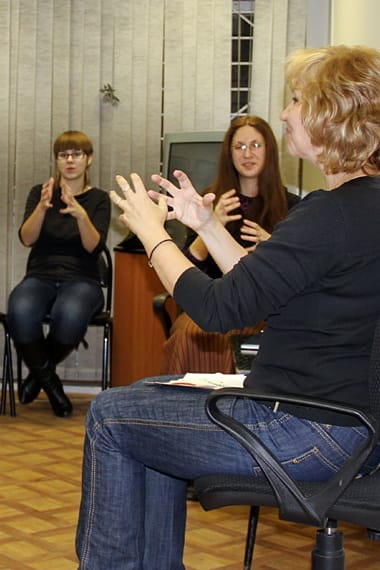Silent language and gestures: sign language, use of gestures
The protagonist of the series "Lie to me" by the uncontrolled movements of a human face could generally tell the whole story for his opponent. However, this skill, although called the ability to read the language of the dumb and their gestures, does not contribute to communication and two-way transmission of information. In other words, mute language and gestures, of course, exist and allow reading certain information, but they do not create a dialogue.
Another thing is sign language. This is a whole system of gestural communication of people with disabilities, where each gesture corresponds to a certain word.
Silent language, gestures: how did sign languages and sign speech arise?
Sign language is not the kind of gesticulation that we use to, for example, communicate with a seller in a market in a foreign country. Oddly enough, sign language is the brainchild of people with hearing and voice. She, in varying degrees, poor or rich, was created in order to be able to communicate silently. Whenever possible, deaf and dumb people borrowed the dumb language, gestures, developing and enriching them.
However, it should be noted that the number of people with hearing or speech defects is actually small. According to some data, completely deaf people worldwide are approximately 0.4% of the total population, and those who constantly use sign language on our planet are about 1.5%. Thus, all sign languages had a very narrow distribution for quite a long time. Their functionally developed and lexically rich variants did not go beyond the circle of communication of a person with a hearing or speech impairment. In fact, these languages could be compared with a cipher, which was invented and known only to a narrow circle of people.
The only exception to this rule is the Urubu tribe in northeastern Brazil, where about one in 75 people are born deaf. Thus, due to the large number of people with a hearing impairment, the entire tribe is familiar with the sign language, which in this tribe is the same for everyone.
The emergence of a common sign language for large territories began only in the middle of the 18th century, when the first educational and educational centers for children with hearing impairments appeared in France and Germany. The purpose of the deaf teachers was to teach the written form of the corresponding (French or German) language. And as a language of mute and sign language for teaching, natural sign languages that arose in the national communities of the deaf were used. It was on their basis that they began to artificially create a gestural interpretation of German and French. Thus, sign languages can be considered largely artificially created.
Teaching mute language and sign communication
The training centers in France and Germany were the first, and therefore it was their graduates who were invited to other countries to create similar schools and develop deaf education. Thus, the spread of sign languages took place. A graduate of the French center, the deaf teacher Laurent Clerc, arrived at the request of the American city of Gallaudet at the end of the same 18th century to create the first school for the deaf in the United States. And it was the ideas and sign language of the French school that were later practiced in the United States. Great Britain limited itself to adopting the methods of deaf pedagogy, and not the language itself. As a result, the American language of the deaf is close to "deaf French" and not to English. To put it bluntly, it has nothing to do with the latter.
In Russia, everything turned out to be somewhat more complicated. The first school, which taught the language of the dumb and gestures, opened in 1806 in Pavlovsk. It was focused on the experience of French teachers and, accordingly, adopted French sign language.
However, half a century later – in 1860 – a school of surdology was opened in Moscow, based on the German methodology. Russian deaf education is still reaping the fruits of the struggle between these two schools.
The creation of the Soviet Union led to the fact that arose in the XIX century. Russian sign language was distributed centrally on the territory of all republics. As a result, it is he who now prevails throughout the entire post-Soviet space.
Sign languages are not a tracing-paper of verbal ones. When we say that American sign language is close to French sign language, we only mean that it was French sign culture that gave rise to American sign language. Both languages have nothing in common with French verbal.
For quite a long time, the structure and history of sign languages was not studied by anyone. However, in the second half of the XX century. several scientists from different countries have proved that sign languages are full-fledged linguistic systems with their own morphological and syntactic features.
Sign Communication: Gestuno Language and Dactyl Sign Alphabet
The Gestuno language (Gestuno) is the name of the international sign language. Despite the fact that sign communication developed according to its own laws, the problem of an international language faced deaf people in the same way as it did before hearing people. In 1951, the World Federation of the Deaf was formed. And the participants of the First World Congress of the Deaf decided to standardize the language of communication at international events – to create a kind of sign Esperanto.
We were looking for common or similar gestures to denote the same things among deaf people from different countries. For almost a quarter of a century, an international sign language has been created. The first dictionary of simplified sign language was released in 1973, and in 1975 in Washington, at the VII World Congress on Deafness, international sign speech was finally adopted and approved.
However, the Gestuno language has a number of significant shortcomings: none of the published dictionaries described the grammatical system of the language, did not disclose the use of gestures in the context, did not explain the artificial principles of the formation of new vocabulary. The vocabulary of the dictionary was completely based on only four sign languages: British, American, Italian and Russian. Gestures from African, Asian and South American national sign languages were not included. At the same time, there is another international system of gestural communication – informal and naturally arising as a result of communication between deaf people from different countries of the world.
Separately, it should be said about the designation of letters of the alphabet with gestures. This is the so-called dactyl alphabet, used to denote common nouns, foreign borrowings, scientific terms, short compounds, prepositions, interjections, etc., that is, words that do not have their own gestural representation. It is impossible to say that dactyl is a sign language. It’s just a gesture alphabet. Moreover, this alphabet also differs in different sign languages.


